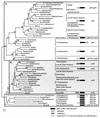Evolutionary analyses of the small subunit of glutamate synthase: gene order conservation, gene fusions, and prokaryote-to-eukaryote lateral gene transfers
- PMID: 12455964
- PMCID: PMC118040
- DOI: 10.1128/EC.1.2.304-310.2002
Evolutionary analyses of the small subunit of glutamate synthase: gene order conservation, gene fusions, and prokaryote-to-eukaryote lateral gene transfers
Abstract
Lateral gene transfer has been identified as an important mode of genome evolution within prokaryotes. Except for the special case of gene transfer from organelle genomes to the eukaryotic nucleus, only a few cases of lateral gene transfer involving eukaryotes have been described. Here we present phylogenetic and gene order analyses on the small subunit of glutamate synthase (encoded by gltD) and its homologues, including the large subunit of sulfide dehydrogenase (encoded by sudA). The scattered distribution of the sudA and sudB gene pair and the phylogenetic analysis strongly suggest that lateral gene transfer was involved in the propagation of the genes in the three domains of life. One of these transfers most likely occurred between a prokaryote and an ancestor of diplomonad protists. Furthermore, phylogenetic analyses indicate that the gene for the small subunit of glutamate synthase was transferred from a low-GC gram-positive bacterium to a common ancestor of animals, fungi, and plants. Interestingly, in both examples, the eukaryotes encode a single gene that corresponds to a conserved operon structure in prokaryotes. Our analyses, together with several recent publications, show that lateral gene transfers from prokaryotes to unicellular eukaryotes occur with appreciable frequency. In the case of the genes for sulfide dehydrogenase, the transfer affected only a limited group of eukaryotes--the diplomonads--while the transfer of the glutamate synthase gene probably happened earlier in evolution and affected a wider range of eukaryotes.
Figures



References
-
- Adams, M. W. W., J. F. Holden, A. L. Menon, G. J. Schut, A. M. Grunden, C. Hou, A. M. Hutchins, F. E. Jenney, C. Kim, K. Ma, G. Pan, R. Roy, R. Sapra, S. V. Story, and M. F. Verhagen. 2001. Key role for sulfur in peptide metabolism and in regulation of three hydrogenases in the hyperthermophilic archaeon Pyrococcus furiosus. J. Bacteriol. 183:716-724. - PMC - PubMed
-
- Andersson, J. O., W. F. Doolittle, and C. L. Nesbø. 2001. Are there bugs in our genome? Science 292:1848-1850. - PubMed
-
- Boucher, Y., and W. F. Doolittle. 2000. The role of lateral gene transfer in the evolution of isoprenoid biosynthesis pathways. Mol. Microbiol. 37:703-716. - PubMed
-
- Brown, J. R., C. J. Douady, M. J. Italia, W. E. Marshall, and M. J. Stanhope. 2001. Universal trees based on large combined protein sequence data sets. Nat. Genet. 28:281-285. - PubMed
Publication types
MeSH terms
Substances
LinkOut - more resources
Full Text Sources
Miscellaneous

